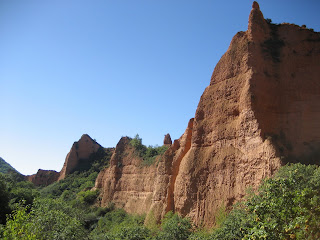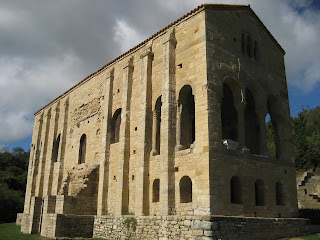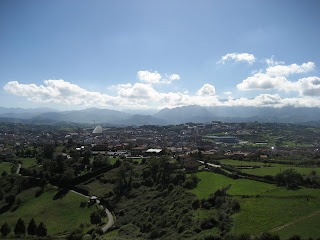I decided to get up really early (7 AM) the next morning so that I could have first dibs on the two functioning toilets for the 40 plus guys in the hostel, as well as not having to wait for the shower. My plan worked, and I was the only person in the bathroom at the time, but unfortunately someone had left all the windows open in there over night, so it was about 40 degrees. The showers also had a water-saving feature that you see in many sinks in public restrooms, where you push a button for the water to come on and it runs for about 20 seconds and then shuts off. You can't select the temperature, and it's really hard to get a shower to warm up when you are only getting 20 second bursts of (freezing cold) water, so after a few minutes I gave up on the shower idea and went back to my warm bed for a few more hours. We ate breakfast in the hostel and then went outside (to the cold, why?) to wait for the whole group to gather, which took a little while.

Home Sweet Hostel
After looking at the Casa Botines for a while, we turned to our right to see our next attraction, the Palacio de los Guzmanes, where the nobles who ruled León lived when it was an independent kingdom. We got a guided tour of the palace by one of its employees, but for some reason this only included the courtyard. It was still pretty informative though, and I will point out some of the things he told us within the photo captions.We walked back to the center of town to see the sights, and our first stop was the Casa Botines, which was designed by Antoni Gaudí. I'm not sure which came first, the Episcopal Palace of Astorga or the Casa Botines, but I could definitely pick up on some of the same design features that marked his work, especially the fairy-tale towers. I haven't done my research but I believe that both of these buildings are earlier works of Gaudí's, because they appear to me more conventional than his well known buildings in Barcelona like the Sagrada Familia and the Parque Güell. Could just be though that the people who commissioned these particular projects didn't want something quite so radical.
 Palacio de los Guzmanes, with Casa Botines on the left. It is now a municipal building of León and as such most visitors are limited to the courtyard.
Palacio de los Guzmanes, with Casa Botines on the left. It is now a municipal building of León and as such most visitors are limited to the courtyard. The courtyard, with the well in the center. The coat of arms of the Guzman family (snakes crawling out of a cauldron) can be seen on the right side. The glass windows enclosing the walkways on the second level was added after the building was renovated in the 1800's to serve its current purpose, and is composed of a variety of scenes from around the province of León. None of the columns on the first level are original, as the originals had deteriorated and were no longer structurally sound.
The courtyard, with the well in the center. The coat of arms of the Guzman family (snakes crawling out of a cauldron) can be seen on the right side. The glass windows enclosing the walkways on the second level was added after the building was renovated in the 1800's to serve its current purpose, and is composed of a variety of scenes from around the province of León. None of the columns on the first level are original, as the originals had deteriorated and were no longer structurally sound. The gargoyles around the courtyard are original and came in pairs that were facing towards each other, which was really typical of the architect who designed this palace. They have been damaged by the weather extremes of the province, where it's really hot in the summer and really cold in the winter (and at night in the fall, as we found out)
The gargoyles around the courtyard are original and came in pairs that were facing towards each other, which was really typical of the architect who designed this palace. They have been damaged by the weather extremes of the province, where it's really hot in the summer and really cold in the winter (and at night in the fall, as we found out)After the tour of the Palacio de los Guzmanes it was around noon, and we were given free time until 4 PM to walk around the rest of León and find something to eat. We headed down the main street leading to the old town, the Calle Ancha (wide street, and it was, compared to most of the other streets in town) and checked out the Cathedral. I think I mentioned this before, but the Cathedral of León has nearly 1800 square meters of stained glass windows and is one of the best examples of this craft in the world. Being a Sunday, mass was going on, but the Cathedral was big enough that tourists were still walking around without really bothering anyone.
 Many of the windows had a floral pattern, but this one was my favorite because it had people and animals. Probably scenes from the Bible, but I don't know which ones . . .
Many of the windows had a floral pattern, but this one was my favorite because it had people and animals. Probably scenes from the Bible, but I don't know which ones . . . Looking straight up at the vaulted ceilings, very impressive
Looking straight up at the vaulted ceilings, very impressiveAfter leaving the Cathedral the group sort of split up, with many of the more hungover foreigners who had stayed out at the discotecas until 5 AM opting to sit around on benches. My friend Miguel and I, along with his Mexican friend Rene and a German girl who doesn't speak much Spanish, decided to go check out the Basilica de San Isidoro, which according to my guide book is also a very important shrine, and one of the stops on the Camino de Santiago. This route, from France to Santiago de Compostela in Galicia, branches into two options somewhere east of Oviedo, so it passes through both Oviedo and León, and is marked by little gold seashells in the sidewalk. I think the route through León is more popular because I saw a ton of backpackers there with seashells hanging from their backpacks, which marks you as a pilgrim, but I haven't seen any in Oviedo.
 I don't know how grave of a sin it is to take a photo of then inside of a Basilica during a Mass, but that's what I did . . .
I don't know how grave of a sin it is to take a photo of then inside of a Basilica during a Mass, but that's what I did . . .At this point we headed back to the Cathedral plaza and met up with some other people, and set off looking for a place to eat lunch. This was easier said than done, because the majority of people wanted to get a menú (a multi-course meal, the actual menus are called "cartas"), but they couldn't find a place with one that was cheap enough for their taste. Our wanderings led us well off the beaten track into a neighborhood that was mostly under construction, at which point Miguel and I decided to split off and go back to a sandwich shop we had seen before. This was a delicious choice, and even more budget friendly than a cheap menú. Afterwards, since we were on our own, Miguel and I headed back towards the hostel to check out something I had seen on the map labeled "Casino". I didn't have very high hopes, because there are a few places in Oviedo called casinos that are shoe stores, but why not. To our surprise, this was a real casino, albeit much smaller than it's Vegas brethren. There was video poker/blackjack and a gaming room with table games that didn't open until 8 PM. Unfortunately this was all moot because you need your Spanish National Identity Card or a passport to enter, and we didn't bring ours along. Oh well, I guess they saved me some money with that rule.
 Miguel reading a brochure about how to play blackjack in front of the casino
Miguel reading a brochure about how to play blackjack in front of the casinoWe still had like an hour and a half to kill before meeting up at the Casa Botines to go to the Museum of Contemporary Art, so we wandered back towards the old town and decided to follow the city walls into some of the older neighborhoods of León. We didn't really see anything of note, a few cool statues and some stray cats, and we ended up hanging out in the plaza in front of the Basilica de San Isidoro with some other people from our group until it was time to go to the meeting place.
 Narrow medieval street
Narrow medieval streetFortunately for our tired legs, the bus was waiting at the Casa Botines, and it took us back to the hostel to collect our belongings before dropping us off in the new part of town where the museum is located. We made a quick stop at a 5 star hotel housed in an old monastery, and then walked a few blocks down to the museum. I want to tell you that this museum was weird, but I really feel like words are lacking to describe it so I'll try to comment on the pictures to give an idea of the place.
 Hahaha this picture gets me everytime. These little girls' mother told them to go stand next to the fat dead clown so she could take their picture. I captured a moment in time in which you can actually see the terrible childhood memories being formed. Also, notice the pools of glitter at the clown's feet.
Hahaha this picture gets me everytime. These little girls' mother told them to go stand next to the fat dead clown so she could take their picture. I captured a moment in time in which you can actually see the terrible childhood memories being formed. Also, notice the pools of glitter at the clown's feet. This was only one wall of a whole room filled with clowns. At the time I just kept thinking about how freaked out anyone who is afraid of clowns (Shannon, Beth, those little girls from before) would be in this room, especially if it was dark when they came in and then the lights were turned on.
This was only one wall of a whole room filled with clowns. At the time I just kept thinking about how freaked out anyone who is afraid of clowns (Shannon, Beth, those little girls from before) would be in this room, especially if it was dark when they came in and then the lights were turned on. Anyway, I had a good time in the MUSAC, even if my shallow comments show how little I really "get" "art" (yeah, they're both in quotes, deal with it). At this point we got back on the bus and headed back to Oviedo, which may have taken a long time or may not have, I wouldn't know because I fell asleep. My next trip will be to Salamanca, Segovia, and Ávila, so look forward to much delayed updates about that in the near to distant future.













































